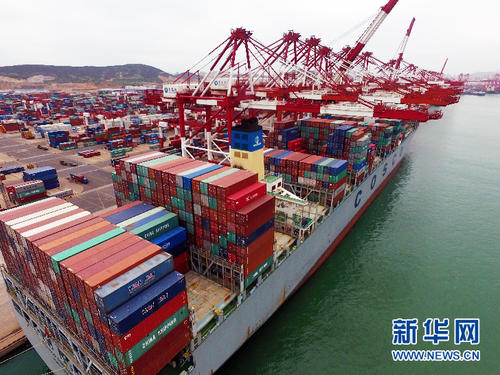

China’s lowering of tariffs on imported products is a strong measure taken to expand opening-up. It will not only contribute to consumption upgrading and the building of a better market environment, but also create more opportunities for global enterprises.

(Photo/Xinhua)
As planned, the country adjusted tariffs for some imported products starting Jan. 1, 2020. It also implemented provisional import tax rates that are lower than the most-favored-nation (MFN) tariff rates for over 850 commodities.
Further tariff reductions have been carried out according to the free trade agreements China has separately signed with New Zealand, Peru, Costa Rica, Switzerland, Iceland, Singapore, Australia, South Korea, Georgia, Chile and Pakistan, as well as the Asia-Pacific Trade Agreement.
Currently, various imported products, including Italian juice and black crabs from Pakistan, have to go through customs clearance before entering China.
China will cut down the MFN rates for 176 items of information technology products from July 1, 2020, and correspondingly adjust the temporary import duty rates for some of these products.
The further lowering of duty on imported products will reduce import costs, stimulate import potential, and satisfy Chinese consumers’ demand for high-quality products, said Gao Feng, spokesperson of the Ministry of Commerce.
Under the duty adjustment scheme, tariffs on frozen Mexican avocados will be reduced to 7 percent from 30 percent, which will enrich the variety of the fruit in the Chinese market and help bring down the prices of homemade avocados.
Tariffs on some pharmaceutical raw materials for the treatment of asthma and diabetes have also been scrapped according to the plan, which will help lower drug costs and promote the development and production of new drugs.
It is believed that South Korea, Japan, and the United States will be among the top beneficiary countries.
Cui Fan, a professor with the University of International Business and Economics, said China has reduced duty on imported products many times since 2015. Most of the products were popular among Chinese consumers, and the tariff rates had been high.
Geoffrey Yu, head of the UK investment office at UBS Wealth Management, said China is in the process of consumption upgrading and its efforts to promote opening-up are impressive.
China’s move to lower tariffs on such a wide range of products is really inspiring, especially when other countries have continued to increase tariffs over the last year, said the Guardian.
 Fire brigade in Shanghai holds group wedding
Fire brigade in Shanghai holds group wedding Tourists enjoy ice sculptures in Datan Town, north China
Tourists enjoy ice sculptures in Datan Town, north China Sunset scenery of Dayan Pagoda in Xi'an
Sunset scenery of Dayan Pagoda in Xi'an Tourists have fun at scenic spot in Nanlong Town, NW China
Tourists have fun at scenic spot in Nanlong Town, NW China Harbin attracts tourists by making best use of ice in winter
Harbin attracts tourists by making best use of ice in winter In pics: FIS Alpine Ski Women's World Cup Slalom
In pics: FIS Alpine Ski Women's World Cup Slalom Black-necked cranes rest at reservoir in Lhunzhub County, Lhasa
Black-necked cranes rest at reservoir in Lhunzhub County, Lhasa China's FAST telescope will be available to foreign scientists in April
China's FAST telescope will be available to foreign scientists in April "She power" plays indispensable role in poverty alleviation
"She power" plays indispensable role in poverty alleviation Top 10 world news events of People's Daily in 2020
Top 10 world news events of People's Daily in 2020 Top 10 China news events of People's Daily in 2020
Top 10 China news events of People's Daily in 2020 Top 10 media buzzwords of 2020
Top 10 media buzzwords of 2020 Year-ender:10 major tourism stories of 2020
Year-ender:10 major tourism stories of 2020 No interference in Venezuelan issues
No interference in Venezuelan issues
 Biz prepares for trade spat
Biz prepares for trade spat
 Broadcasting Continent
Broadcasting Continent Australia wins Chinese CEOs as US loses
Australia wins Chinese CEOs as US loses